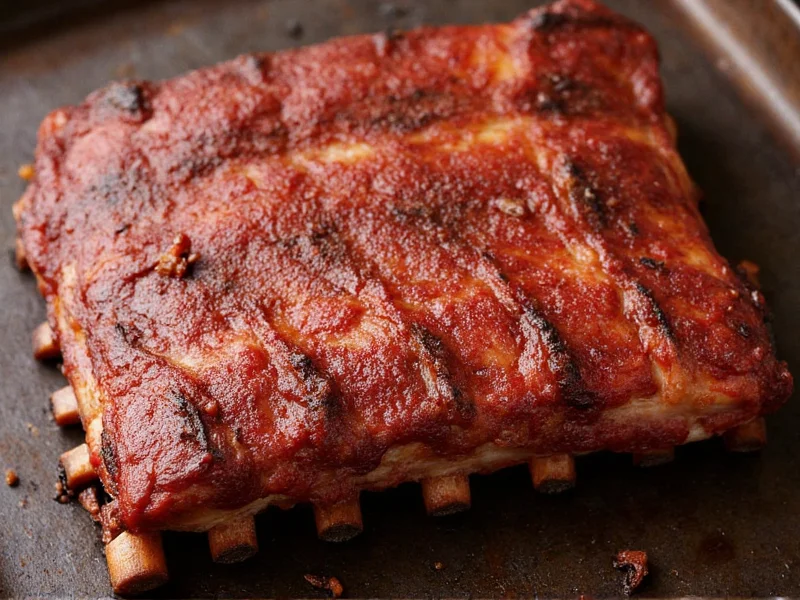Understanding where pork ribs originate requires basic knowledge of pig anatomy and butchering practices. The rib section runs along both sides of the pig's spine, extending from the shoulder area toward the loin. This prime location contains the 11-13 rib bones that form the structural framework for what butchers process into the various rib cuts consumers purchase.
Anatomical Location of Pork Ribs on the Pig
The rib cage of a pig serves as protection for vital organs while providing attachment points for muscles that develop flavor through movement. When butchers process a hog, they separate the carcass into primal cuts. The rib section falls between the shoulder (or picnic) and the loin. This positioning explains why ribs contain both meat and fat in proportions that create exceptional flavor when cooked properly.
Unlike beef ribs which come from multiple sections, pork ribs primarily derive from one continuous section along the upper body. The specific location determines the cut classification:
| Rib Type | Anatomical Location | Characteristics |
|---|---|---|
| Baby Back Ribs | Attached to the loin, near spine | Shorter, curved, leaner, more tender |
| Spare Ribs | Lower portion, extending toward belly | Longer bones, more fat, richer flavor |
| St. Louis Style | Trimmed spare ribs | Square shape, uniform appearance |
| Rib Tips | Cartilage portion of spare ribs | Meaty, often used in Chicago-style BBQ |
Understanding Pork Rib Cuts and Their Origins
Baby back ribs, sometimes called loin back ribs, come from where the rib connects to the spine alongside the loin. These ribs curve upward and are generally meatier on top with less marbling. Their name doesn't indicate age but rather their position "on the baby" or smaller side of the rib cage near the loin.
Spare ribs originate from the lower portion of the rib cage, extending toward the pig's belly. This area contains more fat and connective tissue, which breaks down during slow cooking to create exceptionally tender meat. Butchers often trim spare ribs to create the more uniform St. Louis style ribs popular in barbecue competitions.
The complete rib section typically contains 11-13 bones depending on the pig's breed and size. When butchers remove the loin, they leave the rib bones attached to the side, creating what becomes spare ribs. The portion where ribs connect to the loin becomes baby back ribs.
Butchering Process for Pork Ribs
Professional butchers follow specific procedures to separate rib sections:
- After slaughter and dressing, the hog is split lengthwise along the spine
- The carcass is divided into primal cuts: shoulder, loin, belly, and leg
- The rib section remains attached to either the loin (becoming baby backs) or the belly side (becoming spare ribs)
- Butchers may further process spare ribs by removing the sternum bone and trimming excess fat to create St. Louis style ribs
This careful separation explains why baby back ribs command higher prices—they come from a more premium section of the animal with leaner meat. The anatomical location directly impacts cooking methods, as spare ribs' higher fat content makes them better suited for slow smoking, while baby backs work well with quicker grilling techniques.
Nutritional Profile of Pork Ribs
Understanding where pork ribs come from helps explain their nutritional composition. A 3-ounce serving of cooked pork ribs typically contains:
- Approximately 280-350 calories
- 20-25 grams of protein
- 20-25 grams of fat (depending on trimming)
- Essential nutrients including zinc, selenium, and B vitamins
The fat content varies significantly based on which rib cut you choose and how much visible fat is trimmed. Spare ribs naturally contain more marbling than baby backs due to their anatomical location closer to the pig's belly.
Global Perspectives on Pork Rib Consumption
Pork ribs appear in culinary traditions worldwide, though preparation methods differ based on regional preferences. In American barbecue culture, slow-smoked ribs represent a point of pride, while Chinese cuisine often features braised or steamed spare ribs. Korean cuisine incorporates ribs into dishes like galbi, where the bones are cut thin for faster cooking.
The universal appeal of pork ribs stems from their anatomical structure—meat attached to bone with sufficient fat content to remain moist during cooking. This makes them versatile across cooking methods from grilling to braising to smoking. Understanding which part of pig are ribs from helps cooks select the appropriate cut for their preferred cooking technique.
What part of the pig do baby back ribs come from?
Baby back ribs come from the upper portion of the rib cage where the ribs connect to the spine alongside the loin. This anatomical location makes them shorter, more curved, and generally leaner than other rib cuts.
Are pork ribs and spareribs the same thing?
No, pork ribs is a general term that includes several cuts, while spareribs specifically refer to the lower portion of the rib cage extending toward the pig's belly. Spareribs contain more fat and connective tissue than baby back ribs.
How many ribs does a pig have?
Most pigs have 11-13 pairs of ribs, though this can vary slightly by breed. Butchers typically divide these into two main sections: baby back ribs (6-7 pairs) from the upper portion near the loin, and spareribs (4-6 pairs) from the lower portion toward the belly.
Why are they called baby back ribs if they don't come from baby pigs?
The name refers to their position on the "baby" or smaller side of the rib cage near the spine, not the age of the pig. Baby back ribs come from adult pigs and are named for their curved shape and location alongside the loin.
What's the difference between St. Louis style ribs and regular spare ribs?
St. Louis style ribs are spare ribs that have been trimmed to remove the sternum bone, cartilage, and excess fat, creating a more uniform rectangular shape. This trimming process makes them cook more evenly and gives them their distinctive appearance.











 浙公网安备
33010002000092号
浙公网安备
33010002000092号 浙B2-20120091-4
浙B2-20120091-4